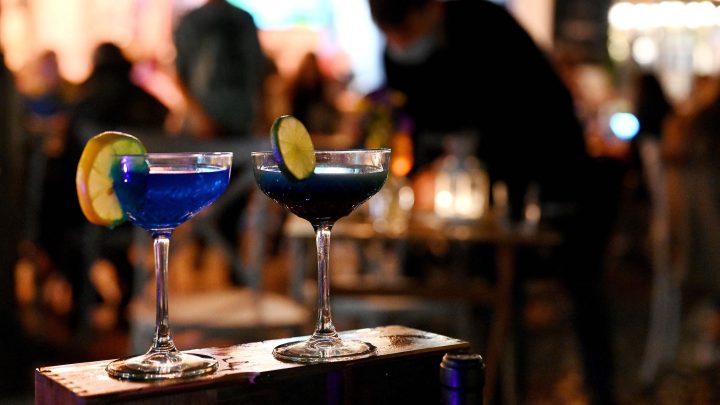
As young consumers drink less, brands and bars offer more and better alternatives
As young consumers drink less, brands and bars offer more and better alternatives

Happy Accidents is a distillery bar with some quirks in Albuquerque’s Nob Hill neighborhood. There’s grass turf on the ceiling, tropical lemur wallpaper and 41 creatively named cocktails on the menu. Right now, five of them are non-alcoholic or low-ABV. Bar manager Tammy Bouma favors the $8 Lap Dance.
“I’ve always been a fan of smoky beverages,” Bouma said as she mixed one up in a whiskey glass with a big square ice cube and a dried orange slice garnish. The drink looks like an old fashioned, but the main ingredient is lapsang souchong tea.
“It’s a tea that’s been smoked over pine needles,” Bouma said. “So you definitely get that forest-y element that makes it a phenomenal kind of almost spirit replacement if you treat it right.”
Historically, non-alcoholic options at bars and restaurants have been underwhelming, said Happy Accidents owner Kate Gerwin.
“You get whatever garnish fruit they have muddled with like some type of lemon juice and soda water. That always felt like a cop out to me,” Gerwin said.
So, she and her staff take the non-alcoholic section of their menu seriously.
“We probably put more time into the non-alcoholic cocktails than we do the alcoholic,” she said. “We try to make sure those cocktails have the same complexity and mouthfeel that alcohol does. So we’re using things like vegetable glycerin, capsaicin oils, tannins from teas.”
Those are the kinds of ingredients that, in expert hands and with a lot of careful tinkering, can approximate the taste, feel and burn of alcohol. Gerwin said these drinks make the bar more inclusive and allow guests to stay out longer and enjoy a few more drinks without paying the price.
The next generation of consumers is drinking less. According to Gallup’s latest poll on the subject, just 62% of adults under 35 drink at all, down 10 percentage points over the last two decades. Fewer drink on a regular basis or report that they drink more than they should.
And with brands, bars and restaurants stepping up to offer more and higher quality alternatives, it’s not a bad time to be sober or sober curious.
“This isn’t to replace alcohol in someone’s life, it’s an option” said Marcus Sakey, founder of Ritual Zero Proof.
Sakey’s company started selling non-alcoholic whiskey, tequila, rum and other spirits in 2019. Back then, he said they were serving a niche market.
“When we would explain what we were selling, people would say ‘Why would I want that?’” Sakey said.
Around 2021, they stopped having to answer that question. After some quarantine overindulgence, a lot of people took a hard look at their relationship with alcohol. Sakey says Ritual Zero Proof’s sales exploded. Now, the spirit alternatives are even sold at Walmart.
“This product is truly mainstreaming,” Sakey said. “It’s becoming an option that people expect.
According to NielsenIQ, the market for non-alcoholic alternatives has seen consistent double-digit growth over the last five years and exceeded half a billion dollars in 2023. And most consumers who are buying those alternatives are also buying traditional beer, wine and spirits.
“What that tells us is that consumers are seeking moderation in their consumption,” said Kaleigh Theriault with NielsenIQ’s beverage alcohol vertical. “Most often they’re looking to either replace [alcohol] on occasion or consume these products when they would normally have had water or soda.”
Theriault is 30 — a younger millennial. She sees these trends showing up in her own social life, with some friends sticking to non-boozy alternatives on weeknights or starting the night with an alcoholic drink, then switching over.
“We’re enjoying a couple of nice drinks and then we’re ready to go home and not ruin the following day for us,” Theriault said.
Christine Whelan studies the wellness economy at the University of Wisconsin-Madison. She said this is one Gen Z and millennial health obsession she can get behind.
“The movement away from alcohol is probably the best of the wellness remedies,” Whelan said, compared to, say, vitamins and supplements, in terms of its proven positive impact on our health.
“There’s improved sleep, mental clarity, people tend to exercise more and be in a better mood,” Whelan said.
She added cutting back on alcohol can save consumers money if they’re sticking with water, though zero-proof alternatives tend to retail for the same price or more.
At Happy Accidents in Albuquerque, non-alcoholic cocktails actually are a little cheaper. Think $9 instead of $14. Last year, owner Kate Gerwin said those drinks made up less than two percent of sales, close to what the bar brings in with beer sales.
“We don’t do it for the money. We do it because it seems like that’s what hospitality should do, right?” Gerwin said. “We want to make sure all our guests are getting the same care no matter what they’re drinking.”
Plus, high quality non-alcoholic options get people in the door.
“People who have a partner that doesn’t drink. Or, you know, have friends in their group who don’t drink so they all come in,” Gerwin said. “So it’s not a huge percentage of our sales, but it’s still important.”
As sometimes-sobriety moves into the mainstream, Gerwin said a reputation for serving a great zero-proof drink goes a long way.
There’s a lot happening in the world. Through it all, Marketplace is here for you.
You rely on Marketplace to break down the world’s events and tell you how it affects you in a fact-based, approachable way. We rely on your financial support to keep making that possible.
Your donation today powers the independent journalism that you rely on. For just $5/month, you can help sustain Marketplace so we can keep reporting on the things that matter to you.











